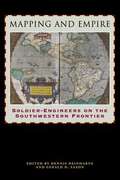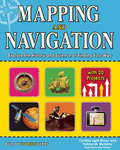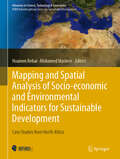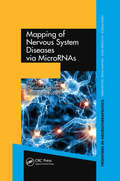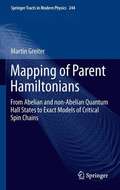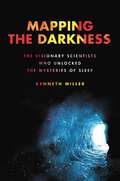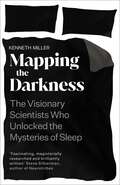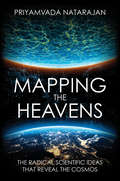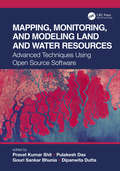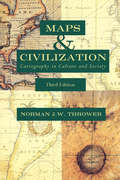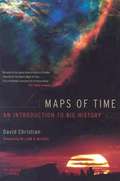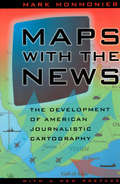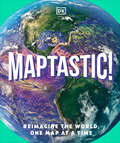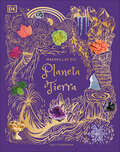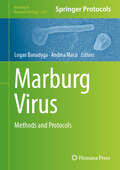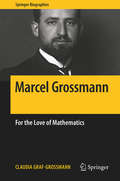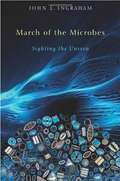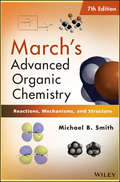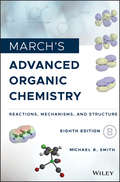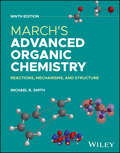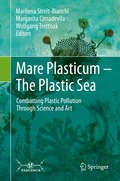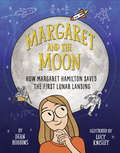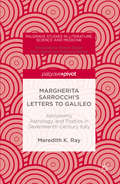- Table View
- List View
Mapping and Empire: Soldier-Engineers on the Southwestern Frontier
by Dennis Reinhartz Gerald D. SaxonFrom the sixteenth through the mid-nineteenth centuries, Spain, then Mexico, and finally the United States took ownership of the land from the Gulf Coast of Texas and Mexico to the Pacific Coast of Alta and Baja California—today's American Southwest. Each country faced the challenge of holding on to territory that was poorly known and sparsely settled, and each responded by sending out military mapping expeditions to set boundaries and chart topographical features.
Mapping and Navigation
by Cynthia Light Brown Beth Hetland Patrick McgintyHow did we get from 20-foot-long maps to GPS devices small enough to fit in the palm of our hands? How does GPS work and what can it tell us? How do ancient mapmaking techniques used by the Romans and Greeks influence the satellite technologies we use today? The history of mapmaking is full of remarkable characters who charted the unknown with an ever-changing set of tools. In Mapping and Navigation: The History and Science of Finding Your Way, kids ages 9-12 will learn the history and science behind the evolution of mapmaking, and how much is still out there for discovery.Readers will explore ideas through hands-on experiments while learning new terminology and interesting facts. Projects include using triangulation to measure distances, creating contour lines on a mini-mountain to understand elevation changes on a map, and inventing a sundial and compass to understand the basics of navigation. Whether mapping the solar system or mapping their own backyard, all readers will be able to understand mapping technologies and see the world in new and exciting ways.
Mapping and Spatial Analysis of Socio-economic and Environmental Indicators for Sustainable Development: Case Studies from North Africa (Advances in Science, Technology & Innovation)
by Noamen Rebai Mohamed MastereThis book presents most recent research studies on mapping and spatial analysis of socio-economic and environmental indicators used by various national and international contributors to regional development projects. It gathers the best contributions to the 1st International Conference on Mapping and Spatial Analysis of Socio-Economic and Environmental Indicators for the Local and Regional Sustainable Development. The conference was held in southern Tunisia, Tataouine in March 2015.The research studies focused on generating and analyzing indicators in various domains of Agriculture, Energy, Industry, Tourism, Transport, Urban Planning, Exploitation of Natural Resources, Infrastructure, Health, Environment, Education, Information and Communication Technologies, Social Affairs and Employability, and Culture and Sport. Socio-economic and environmental indicators are important in regional development plans and strategies as they allow to observe and analyze changes in the economic growth and to measure their impact on the environment and on social networks/daily life of citizens. On the basis of well-defined geomatic approaches, and particularly, through sophisticated digital mapping and spatio-temporal analyses, authors focused on retrieving indicators to evaluate the exploitation rate of natural resources, intensity of the energy consumption in various economic sector, net migratory flows, quality checking of the air in urban areas, adaptation to climate change, and vulnerability of the coastal domain and risk of marine submersion due to sea-level rise. The book is of interest not only to investors and contributors to regional development projects, but also to all relevant policy makers.
Mapping of Nervous System Diseases via MicroRNAs (Frontiers In Neurotherapeutics Ser. #2)
by Christian Barbato Francesca RubertiIn recent years, understanding of microRNA (miRNA) biogenesis, the molecular mechanisms by which miRNAs regulate gene expression, and the functional roles of miRNAs has expanded. Mapping of Nervous System Diseases via MicroRNAs provides an up-to-date review on the function of miRNA in neurological diseases as well as advancements in technology for
Mapping of Parent Hamiltonians
by Martin GreiterThis monograph introduces an exact model for a critical spin chain with arbitrary spin S, which includes the Haldane--Shastry model as the special case S=1/2. While spinons in the Haldane-Shastry model obey abelian half-fermi statistics, the spinons in the general model introduced here obey non-abelian statistics. This manifests itself through topological choices for the fractional momentum spacings. The general model is derived by mapping exact models of quantized Hall states onto spin chains. The book begins with pedagogical review of all the relevant models including the non-abelian statistics in the Pfaffian Hall state, and is understandable to every student with a graduate course in quantum mechanics.
Mapping of Parent Hamiltonians: From Abelian and non-Abelian Quantum Hall States to Exact Models of Critical Spin Chains (Springer Tracts in Modern Physics #244)
by Martin GreiterThis monograph introduces an exact model for a critical spin chain with arbitrary spin S, which includes the Haldane--Shastry model as the special case S=1/2. While spinons in the Haldane-Shastry model obey abelian half-fermi statistics, the spinons in the general model introduced here obey non-abelian statistics. This manifests itself through topological choices for the fractional momentum spacings. The general model is derived by mapping exact models of quantized Hall states onto spin chains. The book begins with pedagogical review of all the relevant models including the non-abelian statistics in the Pfaffian Hall state, and is understandable to every student with a graduate course in quantum mechanics.
Mapping the Darkness: The Visionary Scientists Who Unlocked the Mysteries of Sleep
by Kenneth MillerNAMED A BEST BOOK OF THE YEAR 2023 BY THE NEW YORKER NEW YORK TIMES EDITOR'S CHOICE SELECTION "A propulsive, utterly engrossing history... None of it is simple and all of it is captivating."—The New York Times "Mapping the Darkness offers two narratives at once: a sweeping journey of discovery about dreams, sleep and the terra incognita of unconsciousness; and a wake-up call about the dangers of chronic exhaustion. It&’s time, Mr. Miller tells us, to take our sleep back."—The Wall Street JournalFrom award-winning journalist Kenneth Miller comes the definitive story of the scientists who set out to answer two questions: &“Why do we sleep?&” and "How can we sleep better?&” A century ago, sleep was considered a state of nothingness—even a primitive habit that we could learn to overcome. Then, an immigrant scientist and his assistant spent a month in the depths of a Kentucky cave, making nationwide headlines and thrusting sleep science to the forefront of our consciousness. In the 1920s, Nathaniel Kleitman founded the world&’s first dedicated sleep lab at the University of Chicago, where he subjected research participants (including himself) to a dizzying array of tests and tortures. But the tipping point came in 1938, when his cave experiment awakened the general public to the unknown—and vital—world of sleep. Kleitman went on to mentor the talented but troubled Eugene Aserinsky, whose discovery of REM sleep revealed the astonishing activity of the dreaming brain, and William Dement, a jazz-bass playing revolutionary who became known as the father of sleep medicine. Dement, in turn, mentored the brilliant maverick Mary Carskadon, who uncovered an epidemic of sleep deprivation among teenagers, and launched a global movement to fight it. Award-winning journalist Kenneth Miller weaves together science and history to tell the story of four outsider scientists who took sleep science from fringe discipline to mainstream obsession through spectacular experiments, technological innovation, and single-minded commitment. Readers will walk away with a comprehensive understanding of sleep and why it affects so much of our lives.
Mapping the Darkness: The Visionary Scientists Who Unlocked the Mysteries of Sleep
by Kenneth Miller&‘Fascinating, magisterially researched, and brilliantly written.&’ Steve Silberman, author of Neurotribes Thirty-two days underground. No heat. No sunlight. 4 June 1938. Nathaniel Kleitman and his research student make their way down the seventy-one steps leading to the mouth of Mammoth Cave. They are about to embark on one of the most intrepid and bizarre experiments in medical history, one which will change our understanding of sleep forever. Undisturbed by natural light, they will investigate what happens when you overturn one of the fundamental rhythms of the human body. Together, they enter the darkness. When Kleitman first arrived in New York, a penniless twenty-year-old refugee, few would have guessed that in just a few decades he would revolutionise the field of sleep science. In Mapping the Darkness, Kenneth Miller weaves science and history to tell the story of the outsider scientists who took sleep science from the fringes to a mainstream obsession. Reliving the spectacular experiments, technological innovation, imaginative leaps and single-minded commitment of these early pioneers, Miller provides a tantalising glimpse into the most mysterious third of our lives.
Mapping the Heavens: The Radical Scientific Ideas That Reveal the Cosmos
by Priyamvada NatarajanA theoretical astrophysicist explores the ideas that transformed our knowledge of the universe over the past century. The cosmos, once understood as a stagnant place, filled with the ordinary, is now a universe that is expanding at an accelerating pace, propelled by dark energy and structured by dark matter. Priyamvada Natarajan, our guide to these ideas, is someone at the forefront of the research—an astrophysicist who literally creates maps of invisible matter in the universe. She not only explains for a wide audience the science behind these essential ideas but also provides an understanding of how radical scientific theories gain acceptance. The formation and growth of black holes, dark matter halos, the accelerating expansion of the universe, the echo of the big bang, the discovery of exoplanets, and the possibility of other universes—these are some of the puzzling cosmological topics of the early twenty-first century. Natarajan discusses why the acceptance of new ideas about the universe and our place in it has never been linear and always contested even within the scientific community. And she affirms that, shifting and incomplete as science always must be, it offers the best path we have toward making sense of our wondrous, mysterious universe. &“Part history, part science, all illuminating. If you want to understand the greatest ideas that shaped our current cosmic cartography, read this book.&”—Adam G. Riess, Nobel Laureate in Physics, 2011 &“A highly readable, insider&’s view of recent discoveries in astronomy with unusual attention to the instruments used and the human drama of the scientists.&”—Alan Lightman, author of The Accidental Universe and Einstein's Dream
Mapping, Monitoring, and Modeling Land and Water Resources: Advanced Techniques Using Open Source Software
by Pravat Kumar Shit, Pulakesh Das, Gouri Sankar Bhunia, and Dipanwita DuttaThe wide range of challenges in studying Earth system dynamics due to uncertainties in climate change and complex interference from human activities is creating difficulties in managing land and water resources and ensuring their sustainable use. Mapping, Monitoring, and Modeling Land and Water Resources brings together real-world case studies accurately surveyed and assessed through spatial modeling. The book focuses on the effectiveness of combining remote sensing, geographic information systems, and R. The use of open source software for different spatial modeling cases in various fields, along with the use of remote sensing and geographic information systems, will aid researchers, students, and practitioners to understand better the phenomena and the predictions by future analyses for problem-solving and decision-making.
Maps & Civilization: Cartography in Culture and Society
by Norman J. ThrowerIn this concise introduction to the history of cartography, Norman J. W. Thrower charts the intimate links between maps and history from antiquity to the present day. A wealth of illustrations, including the oldest known map and contemporary examples made using Geographical Information Systems (GIS), illuminate the many ways in which various human cultures have interpreted spatial relationships. The third edition of Maps and Civilization incorporates numerous revisions, features new material throughout the book, and includes a new alphabetized bibliography. Praise for previous editions of Maps and Civilization: “A marvelous compendium of map lore. Anyone truly interested in the development of cartography will want to have his or her own copy to annotate, underline, and index for handy referencing.”—L. M. Sebert, Geomatica
Maps of Time: An Introduction to Big History
by William H. Mcneill David ChristianA history of the world from the big bang to the present. "Big history" is a new approach to world history that joins the history of the world as a physical entity to human history. David Christian is the leading proponent of this approach to world history.
Maps with the News: The Development of American Journalistic Cartography (John D. And Catherine T. Macarthur Foundation Series On Mental Health And Development)
by Mark MonmonierMaps with the News is a lively assessment of the role of cartography in American journalism. Tracing the use of maps in American news reporting from the eighteenth century to the 1980s, Mark Monmonier explores why and how journalistic maps have achieved such importance. "A most welcome and thorough investigation of a neglected aspect of both the history of cartography and modern cartographic practice."—Mapline "A well-written, scholarly treatment of journalistic cartography. . . . It is well researched, thoroughly indexed and referenced . . . amply illustrated."—Judith A. Tyner, Imago Mundi "There is little doubt that Maps with the News should be part of the training and on the desks of all those concerned with producing maps for mass consumption, and also on the bookshelves of all journalists, graphic artists, historians of cartography, and geographic educators."—W. G. V. Balchin, Geographical Journal "A definitive work on journalistic cartography."—Virginia Chipperfield, Society of University Cartographers Bulletin
Maptastic!: Reimagine the World, One Map at a Time
by DKChange how you see our world with this book of mind-blowing and beautiful maps for children.Curiosity meets cartography in this brilliant book of maps for children aged 9-12, showcasing different countries and habitats from around the world.From the Roman Empire to medieval sea monsters to shipwrecks, Maptastic! showcases the craziest, most mind-blowing, and most spectacular maps you’ve ever seen. Children can explore ingenious and detailed maps that turn data into captivating visual stories.This map book for kids offers:A collection of diverse maps from all over the world that show children unique and fresh perspectives on each place.Diagrams and annotations on each map to break down different concepts and topics.An educational and entertaining book that sparks curiosity in geography, history, and data science.Where do swallows go for winter? What’s under Antarctica’s ice? Where on Earth would you find the most money, the deadliest animals, the strangest place names, or the best place to see a tornado or a volcano?Delve into the wonders of science with maps on geology, climate, astronomy, and nature, and find out how the world's worst maps led to some of the greatest discoveries of history. This map book is perfect for trivia lovers and map geeks of all ages.
Maptastic!: Reimagine the World, One Map at a Time
by DKChange how you see our world with this book of mind-blowing and beautiful maps for children.Curiosity meets cartography in this brilliant book of maps for children aged 9-12, showcasing different countries and habitats from around the world.From the Roman Empire to medieval sea monsters to shipwrecks, Maptastic! showcases the craziest, most mind-blowing, and most spectacular maps you’ve ever seen. Children can explore ingenious and detailed maps that turn data into captivating visual stories.This map book for kids offers:A collection of diverse maps from all over the world that show children unique and fresh perspectives on each place.Diagrams and annotations on each map to break down different concepts and topics.An educational and entertaining book that sparks curiosity in geography, history, and data science.Where do swallows go for winter? What’s under Antarctica’s ice? Where on Earth would you find the most money, the deadliest animals, the strangest place names, or the best place to see a tornado or a volcano?Delve into the wonders of science with maps on geology, climate, astronomy, and nature, and find out how the world's worst maps led to some of the greatest discoveries of history. This map book is perfect for trivia lovers and map geeks of all ages.
Maravillas del Planeta Tierra (DK Children's Anthologies)
by Cally OldershawExplora la belleza del planeta Tierra a través de más de 100 historias acompañadas de increíbles imágenes y fotografías.Maravillas del planeta Tierra es un libro de geología que explica de manera fácil y entretenida cómo funciona la Tierra. Los niños emprenderán un recorrido visual por sus páginas para descubrir las capas y los elementos de la naturaleza de nuestro planeta, empezando por el núcleo metálico, la dura corteza terrestre y la superficie (con sus fascinantes océanos y montañas), hasta llegar a la atmósfera y los fenómenos climáticos. En su interior, encontrarás: Narraciones acompañadas de explicaciones y datos científicos sobre el funcionamiento del planeta y los fenómenos de la naturaleza, como los copos de nieve y las perlas de las cavernas.Impresionantes fotografías que capturan la naturaleza en acción y objetos naturales muy de cerca.Páginas dedicadas a cada capa de la Tierra con información muy completa, para explorarlas con mayor detalle.¿A qué esperas para descubrir todos los misterios de nuestro cambiante planeta? Con laminado dorado en la cubierta, páginas con bordes dorados y cinta marcapáginas, este libro es un regalo muy bonito para futuros geólogos, geógrafos, ambientalistas y entusiastas del planeta Tierra de todo el mundo.Este libro pertenece a la famosa colección Anthology de DK en español. Complétala y acompaña a tu hijo a explorar el mundo natural con Maravillas naturales, a aprenderlo todo sobre los dinosaurios que gobernaron la tierra con Dinosaurios y vida prehistórica, o a sumergirse en las profundidades de los mares y océanos con Maravillas del mundo acuático.Explore the beauty and majesty of planet Earth in this compendium, with more than 100 incredible stories and images.An Anthology of Our Extraordinary Earth looks at our constantly changing planet, with striking images and scientific ideas that are easy for children to understand. Starting at the centre of the Earth, the book examines each layer in forensic detail: from Earth’s metallic core, drilling through Earth’s tough crust until emerging out onto the planet’s surface, with its lush green rainforests, sparkling oceans, and snow-capped mountains, before sailing up into Earth’s airy atmosphere. This detailed planet Earth book for kids offers: - More than 100 stories about planet Earth, from snowflakes to cave pearls, each one accompanied by a photograph and delightful illustration. - Creative photography that presents planet Earth in surprising and remarkable ways, capturing nature in action or showing intriguing features up close. - Beautiful gold foil, gilded edges, and a ribbon for keeping your place. - In-depth feature pages that examine each layer of Earth. This striking book won’t fail to excite budding geologists, geographers, environmentalists, and all-round planet Earth enthusiasts everywhere.
Marburg Virus: Methods and Protocols (Methods in Molecular Biology #2877)
by Andrea Marzi Logan BanadygaThis volume explores the latest advancements in the study of the Marburg virus. The first few chapters in this book review the challenges associated with developing effective medical countermeasures against this virus, while the rest of the chapters provide protocols on ways to achieve these goals. Some of the topics covered in this book include virus isolation and propagation; single-cell transcriptional profiling; reverse genetics systems; proteomics analyses; next-generation sequencing techniques; protocols detailing the use of various animal models including bats and nonhuman primates; and methods for assessing virus stability or validating virus inactivation. Written in the highly successful Methods in Molecular Biology series format, chapters include introductions to their respective topics, lists of the necessary materials and reagents, step-by-step, readily reproducible laboratory protocols, and tips on troubleshooting and avoiding known pitfalls. Cutting-edge and thorough, Marburg Virus: Methods and Protocols is a valuable resource for all researchers interested in advancing their understanding of this virus.
Marcel Grossmann: For the Love of Mathematics (Springer Biographies)
by William D. Brewer Claudia Graf-GrossmannZurich, summer 1912. Albert Einstein has just returned from Prague to the city on the Limmat. He sends a plea for help to his former fellow student, the mathematician Marcel Grossmann (1878-1936), for he is in need of assistance with the mathematical calculations of his general theory of relativity. What then follows is one of the most fascinating chapters of science history, with far-reaching consequences for the lives of the two friends. Marcel Grossmann’s granddaughter paints here a picture of a fiery and many-talented scientist and patriot. She traces the influence of an entrepreneurial family during Germany’s rapid industrial expansion in the late 19th century. The family’s fluctuating fortunes take the story to the vibrant city of Budapest on the Danube; they enable readers to sense the pioneering spirit at Zurich’s young Polytechnic Institute (now ETH Zurich) – but also reflect the worries and hardships of the First World War and interwar years. The Foreword is written by Prof. Remo Ruffini, founder and president of the International Center for Relativistic Astrophysics and the Marcel Grossmann Meetings. Last but not least, an extensive contribution by Dr. Tilman Sauer offers a scientific-historical appreciation of Marcel Grossmann’s enduring contributions.
March Of The Microbes: Sighting The Unseen
by John L. Ingraham Roberto KolterA Choice Outstanding Academic Title Renowned microbiologist John Ingraham rescues the supremely important and ubiquitous microorganisms from their unwonted obscurity by showing us how we can, in fact, see and appreciate them.
March's Advanced Organic Chemistry
by Michael B. SmithThe new, revised and updated 7th edition of March's Advanced Organic Chemistry clearly explains the theories and examples of organic chemistry, providing the most comprehensive resource about organic chemistry available. Readers are guided on planning and execution of multi-step synthetic reactions, with detailed descriptions of all the reactions. The first five chapters deal with the structure of organic compounds and discuss important organic chemistry bonds, fundamental principles of conformation, and stereochemistry of organic molecules, and reactive intermediates in organic chemistry. Chapters 6 to 9 are concerned with general principles of mechanism in organic chemistry, including acids and bases, photochemistry, sonochemistry and microwave irradiation, and finally the relationship between structure and reactivity. The last 10 chapters cover the nature and the scope of organic reactions and their mechanisms. The 7th edition proves again it is a must-have desktop reference and textbook for every student and professional working in organic chemistry or related fields. Key features of the 7th edition: Every chapter has been updated with the most recent reaction information with references to both the primary and review literature New to the 7th edition: 5,500 references since the last edition, updates / rewrites of the retained sections, and an updated index in Appendix B Contains more than 1650 reactions and 20,000 valuable references to the primary literature Includes appendices on the literature of organic chemistry and the classification of reactions according to the compounds synthesized Guides the reader on planning and execution of multi-step synthetic reactions, with detailed descriptions of all the reactions. Reviews of the previous edition: "...a favorite general organic chemistry text and an easy-to-use one-volume reference. We are confident that this book will remain a dominant reference and that it will reside on many chemists' personal bookshelves." -Journal of Medicinal Chemistry "Who can hope to be seriously accepted as a member of the organic chemistry community without being in possession of at least one edition of 'March'?" -Chemistry and Industry
March's Advanced Organic Chemistry: Reactions, Mechanisms, and Structure
by Michael B. SmithThe completely revised and updated, definitive resource for students and professionals in organic chemistry The revised and updated 8th edition of March's Advanced Organic Chemistry: Reactions, Mechanisms, and Structure explains the theories of organic chemistry with examples and reactions. This book is the most comprehensive resource about organic chemistry available. Readers are guided on the planning and execution of multi-step synthetic reactions, with detailed descriptions of all the reactions The opening chapters of March's Advanced Organic Chemistry, 8th Edition deal with the structure of organic compounds and discuss important organic chemistry bonds, fundamental principles of conformation, and stereochemistry of organic molecules, and reactive intermediates in organic chemistry. Further coverage concerns general principles of mechanism in organic chemistry, including acids and bases, photochemistry, sonochemistry and microwave irradiation. The relationship between structure and reactivity is also covered. The final chapters cover the nature and scope of organic reactions and their mechanisms. This edition: Provides revised examples and citations that reflect advances in areas of organic chemistry published between 2011 and 2017 Includes appendices on the literature of organic chemistry and the classification of reactions according to the compounds prepared Instructs the reader on preparing and conducting multi-step synthetic reactions, and provides complete descriptions of each reaction The 8th edition of March's Advanced Organic Chemistry proves once again that it is a must-have desktop reference and textbook for every student and professional working in organic chemistry or related fields.
March's Advanced Organic Chemistry: Reactions, Mechanisms, and Structure
by Michael B. SmithLeading reference on the theories of organic chemistry, now updated to reflect the most recent literature from 2018 to 2023 Building on the success of the 8th Edition as winner of the Textbook & Academic Authors Association 2021 McGuffey Longevity Award, the revised and updated 9th Edition of March’s Advanced Organic Chemistryexplains the theories of organic chemistry, covers new advances in areas of organic chemistry published between 2018 and 2023, and guides readers to plan and execute multi-step synthetic reactions. Detailed examples and descriptions of all reactions are included throughout the text. As in previous editions, the goal of this edition is to give equal weight to three fundamental aspects of the study of organic chemistry: reactions, mechanisms, and structure. Specific but specialized areas of organic chemistry, such as terpenes, polymerization, and steroids, have been incorporated into primary sections rather than segregated into their own sections. The first nine chapters cover general organic chemistry with theoretical principles. The next 10 chapters address reactions and mechanistic discussion. Appendix A focuses on literature references and resources. More than 4,400 references are included throughout the text. March’s Advanced Organic Chemistry provides information on: Localized and delocalized chemical bonding and bonding weaker than covalentMicrowave chemistry, use of ultrasound, mechanochemistry, and reactions done under flow conditionsAcids and bases, irradiation processes, stereochemistry, structure of intermediates, and ordinary and photochemical reactionsMechanisms and methods of determining carbocations, carbanions, free radicals, carbenes, and nitrenesAliphatic, alkenyl, and alkynyl substitution, additions to carbon-carbon and carbon-hetero bonds, eliminations, rearrangements, and oxidations and reductions This 9th Edition of March’s Advanced Organic Chemistry continues to serve as a must-have reference for every student and professional working in organic chemistry or related fields.
Mare Plasticum - The Plastic Sea: Combatting Plastic Pollution Through Science and Art
by Marilena Streit-Bianchi Margarita Cimadevila Wolfgang TrettnakThis book, written by a multidisciplinary team of authors comprising scientists, artists and communicators, explores one of the most pressing issues of our time – the menace plastics pose to marine environments and organisms. It takes readers on a journey that begins on the beaches of Galicia, where the beach litter formed the starting point for an exhibition that combines art and science to alert the audience to the urgent need for action. The journey culminates with a short “plastic story”, which reveals a disturbing vision of the future significance of plastics for humans, and an example of how comics can deliver information to a younger audience. Along the way there is plenty of fascinating science, such as insights into the impacts of plastics and microplastics; the new marine ecosystem, known as the “plastisphere”; and the current status of the oceans, from the Arctic to the Mediterranean. The book also explores the historical developments; sustainable solutions, including the use of circular economy methodologies; and protective measures, like those being tried in China and the Far East. Lastly, it describes the role played by rivers as transport vectors for plastic, with special reference to the Danube, and to complete the picture, since most of the plastic is of terrestrial origin, it investigates problems related to microplastics in soils.
Margaret and the Moon
by Dean RobbinsA true story from one of the Women of NASA!Margaret Hamilton loved numbers as a young girl. She knew how many miles it was to the moon (and how many back). She loved studying algebra and geometry and calculus and using math to solve problems in the outside world. Soon math led her to MIT and then to helping NASA put a man on the moon! She handwrote code that would allow the spacecraft&’s computer to solve any problems it might encounter. Apollo 8. Apollo 9. Apollo 10. Apollo 11. Without her code, none of those missions could have been completed. Dean Robbins and Lucy Knisley deliver a lovely portrayal of a pioneer in her field who never stopped reaching for the stars.
Margherita Sarrocchi's Letters to Galileo: Astronomy, Astrology, and Poetics in Seventeenth-Century Italy (Palgrave Studies in Literature, Science and Medicine)
by Meredith K. RayThis book examines a pivotal moment in the history of science and women’s place in it. Meredith Ray offers the first in-depth study and complete English translation of the fascinating correspondence between Margherita Sarrocchi (1560-1617), a natural philosopher and author of the epic poem, Scanderbeide (1623), and famed astronomer, Galileo Galilei. Their correspondence, undertaken soon after the publication of Galileo’s Sidereus Nuncius, reveals how Sarrocchi approached Galileo for his help revising her epic poem, offering, in return, her endorsement of his recent telescopic discoveries. Situated against the vibrant and often contentious backdrop of early modern intellectual and academic culture, their letters illustrate, in miniature, that the Scientific Revolution was, in fact, the product of a long evolution with roots in the deep connections between literary and scientific exchanges.
